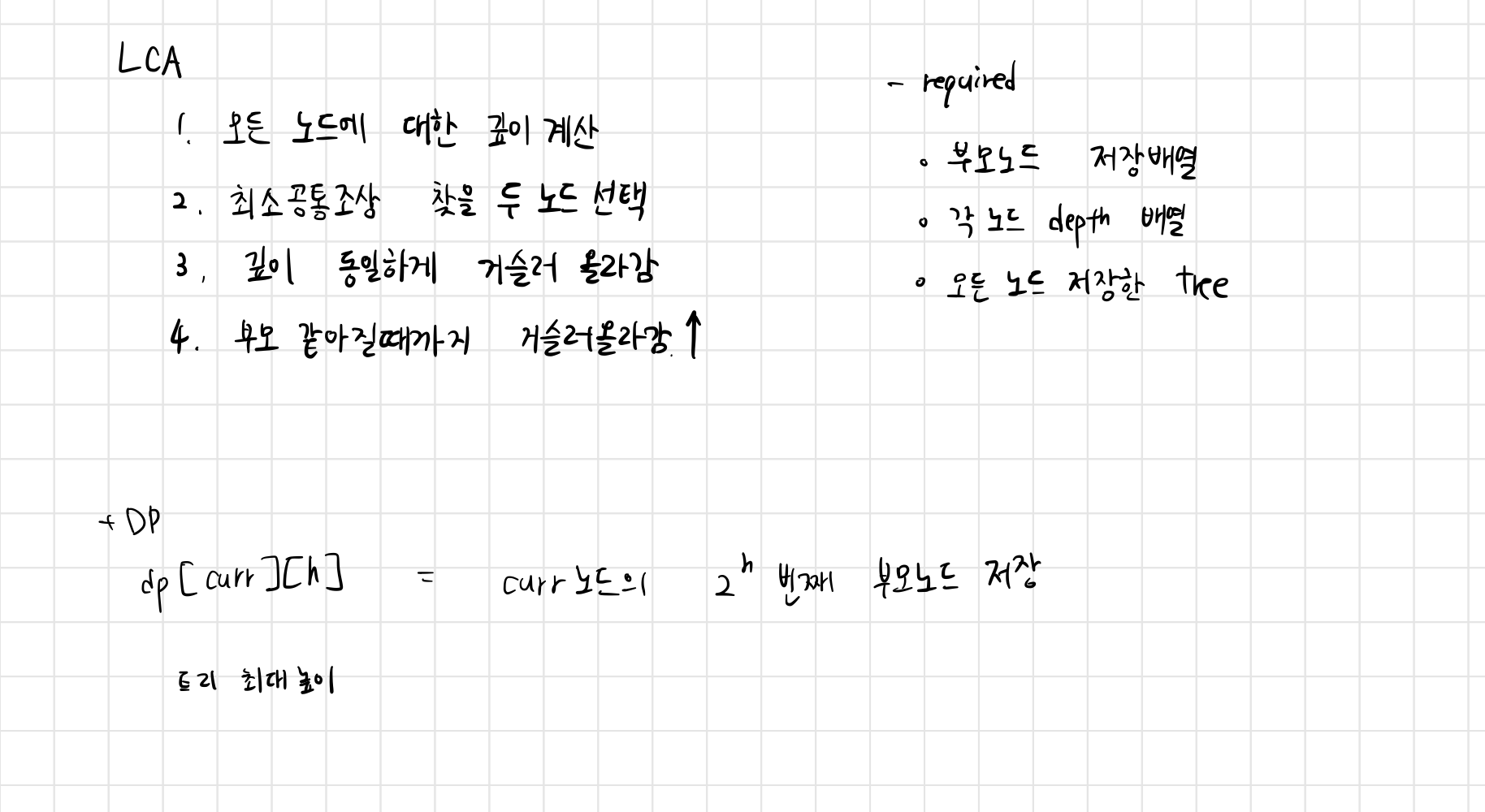BOJ_11438_LCA 2 (Java)
BOJ_11438_LCA 2 (Java)
[Platinum V] LCA 2 - 11438
### 성능 요약
메모리: 108964 KB, 시간: 952 ms
### 분류
자료 구조, 최소 공통 조상, 희소 배열, 트리
### 제출 일자
2025년 4월 16일 23:37:54
### 문제 설명
N(2 ≤ N ≤ 100,000)개의 정점으로 이루어진 트리가 주어진다. 트리의 각 정점은 1번부터 N번까지 번호가 매겨져 있으며, 루트는 1번이다.
두 노드의 쌍 M(1 ≤ M ≤ 100,000)개가 주어졌을 때, 두 노드의 가장 가까운 공통 조상이 몇 번인지 출력한다.
### 입력
첫째 줄에 노드의 개수 N이 주어지고, 다음 N-1개 줄에는 트리 상에서 연결된 두 정점이 주어진다. 그 다음 줄에는 가장 가까운 공통 조상을 알고싶은 쌍의 개수 M이 주어지고, 다음 M개 줄에는 정점 쌍이 주어진다.
### 출력
M개의 줄에 차례대로 입력받은 두 정점의 가장 가까운 공통 조상을 출력한다.
문제 풀이
- 트리에 대한 정보가 주어지고 두 노드의 가장 가까운 공통 조상 노드를 결과로 출력
- 루트 노드는 항상 1번
- 트리의 각 정점은 1번~N번까지 존재
- 입력된 트리의 정보를 저장
- 입력된 정보로 트리 형성 및 부모 노드(DP)와 깊이를 따로 저장
- M개의 노드 쌍에 대한 공통 조상 노드를 찾아서 결과로 출력
DP 구성하기 (희소 배열)
조상 노드에 대한 메모이제이션으로 dp[][]를 구성
-
dp[m][n] = m번 노드의 2ⁿ만큼 위에 있는 부모 노드를 가리킴
-
점화식 :
dp[m][n] = dp[dp[m][n-1]][n-1]
공통 조상 노드 구하기
-
두 노드의 깊이가 다르면 깊이가 같아지도록 맞춤
-
이진 탐색(희소 배열)을 이용해 탐색 횟수를 줄임
-
깊이가 같아지면 부모 노드로 동시에 이동하며 같은 노드를 가리킬 때까지 반복
코드
1
2
3
4
5
6
7
8
9
10
11
12
13
14
15
16
17
18
19
20
21
22
23
24
25
26
27
28
29
30
31
32
33
34
35
36
37
38
39
40
41
42
43
44
45
46
47
48
49
50
51
52
53
54
55
56
57
58
59
60
61
62
63
64
65
66
67
68
69
70
71
72
73
74
75
76
77
78
79
80
81
82
83
84
85
86
87
88
89
90
91
92
93
94
95
96
97
98
99
100
101
102
103
104
105
106
107
108
109
110
111
112
113
114
115
/**
* Author: nowalex322, Kim HyeonJae
*/
import java.io.*;
import java.util.*;
public class Main {
static BufferedReader br;
static BufferedWriter bw;
static StringTokenizer st;
static int N, M, maxH;
static int[] depth;
static int[][] dp;
static ArrayList<Integer>[] tree;
public static void main(String[] args) throws Exception {
new Main().solution();
}
public void solution() throws Exception {
br = new BufferedReader(new InputStreamReader(System.in));
// br = new BufferedReader(new InputStreamReader(new FileInputStream("src/main/java/BOJ_11438_LCA2/input.txt")));
bw = new BufferedWriter(new OutputStreamWriter(System.out));
N = Integer.parseInt(br.readLine());
// 트리의 maxH
for(int i=1; i<=N; i*=2){
maxH++;
}
dp = new int[N+1][maxH];
depth = new int[N+1];
tree = new ArrayList[N+1];
for(int i=0; i<=N; i++){
tree[i] = new ArrayList<>();
}
for(int i=1; i<N; i++){
st = new StringTokenizer(br.readLine());
int u = Integer.parseInt(st.nextToken());
int v = Integer.parseInt(st.nextToken());
tree[u].add(v);
tree[v].add(u);
}
initTree(1, 1, 0);
initParent();
M = Integer.parseInt(br.readLine());
for(int i=1; i<=M; i++){
st = new StringTokenizer(br.readLine());
int a = Integer.parseInt(st.nextToken());
int b = Integer.parseInt(st.nextToken());
bw.write(LCA(a, b) + "\n");
}
bw.flush();
bw.close();
br.close();
}
private static int LCA(int a, int b) {
int a_h = depth[a];
int b_h = depth[b];
// a높이 항상 크게 유지
if(a_h < b_h){
int tmp = a;
a = b;
b = tmp;
}
//같은 높이에서 시작하게 높이 맞추기
for(int i=maxH-1; i>=0; i--){
a_h = depth[a];
b_h = depth[b];
int depthGap = a_h - b_h;
if(Math.pow(2, i) <= depthGap) a = dp[a][i]; //희소 배열처럼 점프
}
if(a==b) return a;
// 같은 부모 가리킬때까지 위로 진행 (같은 높이)
for(int i=maxH-1; i>=0; i--){
if(dp[a][i] != dp[b][i]){
a = dp[a][i];
b = dp[b][i];
}
}
return dp[a][0];
}
private void initParent() { // dp(부모저장2차원배열) 점화식
for(int h=1; h<maxH; h++){
for(int node=1; node<=N; node++){
dp[node][h] = dp[dp[node][h-1]][h-1]; // node의 2^h번째 부모 = (node의 부모)의 2^(h-1)번째 부모
}
}
}
private static void initTree(int child, int parent, int d) { // 재귀적으로 아래로 내려가며 트리 형태 만들기
depth[child] = d;
dp[child][0] = parent;
for(int next : tree[child]){
if(next == parent) continue;
initTree(next, child, d+1);
}
}
}
This post is licensed under
CC BY 4.0
by the author.

